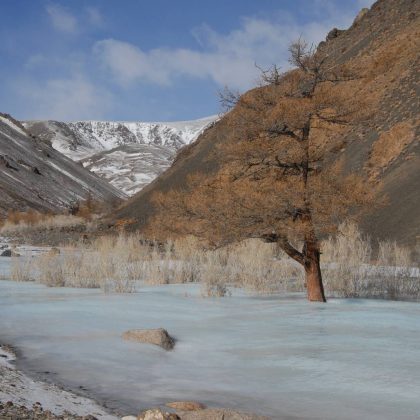Evidence for Presence of Snow Leopards Only Found in 75% of Himachal Pradesh’s Potential Habitat
Study finds that snow leopards only use three quarters of the presumed snow leopard habitat in Himachal Pradesh, India, raising questions about the way we map the cat’s distribution.
Due to a lack of empirical data, our understanding of the distribution and abundance of the elusive snow leopard depends to a large extent on geophysical models of the cat’s habitat.
Most experts estimate the snow leopard’s potential range in the high mountains of East and Central Asia to be between 1.5 and 2 million square kilometers – an area possibly as large as Mexico.
In certain parts of this vast area, we know snow leopards are present because the cats or their signs (scat, scrape marks) have been recorded in scientific studies (less than 2% of the total potential habitat). In other parts, there are reliable accounts from local people. But a large majority of what is presumed to be snow leopard habitat haven’t ever been studied systematically, so nobody really knows if there are any snow leopards.
Instead, experts consider factors such as geographical location, altitude, climate or terrain. If these factors match, an area is assumed to be suitable for snow leopards – and so it becomes part of the estimated 1.5 to 2 million square kilometer range of this cat.
This approach has clear limitations. Good habitat areas may be missed, e.g. because they are a lower altitude than what is considered typical. On the other hand, areas that don’t actually have any cats may be falsely considered to be snow leopard habitat simply because their geophysical properties match certain criteria.
This has wide-ranging implications: if our assumptions of where snow leopards occur are inaccurate, any population estimate built on these assumptions – whether it’s for a region or globally – will be inaccurate as well. To reduce this uncertainty, researchers with India’s Nature Conservation Foundation (NCF), the Wildlife Institute of India and the US-based Snow Leopard Trust wanted to get a more accurate picture of where these cats really live, and how that may have changed over time. They published their surprising findings in the scientific journal Oryx this month.
“We systematically interviewed local people across the state of Himachal Pradesh to find out where snow leopards occur today, and where they used to occur 30 years ago”, says Abhishek Ghoshal, the study’s lead author.
“We found that snow leopards only use 75% of what we presumed to be snow leopard habitat in the state”, Ghoshal says. “In the remaining 25%, there don’t seem to have been any cats in the last 30 years.”
While the interviews Ghoshal and his team conducted give reliable information on whether snow leopards occur in a certain area, they don’t provide information about how many of these elusive cats there are – so it’s impossible to say whether the population has grown or declined.
But the researchers at least found out that the snow leopard distribution in Himachal Pradesh hasn’t changed significantly since the mid 1980s. “It’s unlikely that the snow leopard has disappeared from any sites in Himachal Pradesh in the last three decades, which is a positive sign”, added Kulbhushansingh Suryawanshi, a co-author on the paper and director of the Snow Leopard Trust’s India Program. “But we also need to be mindful of the fact that the snow leopard range hasn’t expanded to any new areas in that time.”
Prey is key factor
While Ghoshal and his colleagues revealed that existing global habitat models for snow leopards do not fit Himachal Pradesh very well, the study also showed one possible better way to predict where snow leopards occur at vast spatial and long temporal scales: “The actual snow leopard habitat in Himachal Pradesh seems to overlap exactly with the distribution of prey species like ibex and blue sheep. Wherever we found one of the prey species, we found snow leopards as well.”
This result confirms earlier research that suggested prey was the most important condition for snow leopards to thrive. “Where there is no prey, there can be no predator. And at the scale of this work, whether the prey is ibex or blue sheep doesn’t seem to matter for snow leopards. As long as ibex or blue sheep are there, the snow leopard has a chance to persist in the long term”, Ghoshal says.
However, the list of threats to the cat remains long, according to Yash Veer Bhatnagar, a senior scientist with NCF: “Traditional threats, such as intense migratory livestock grazing and hunting by local communities, continue to persist in some areas, while new threats related to an unprecedented thrust on infrastructure development in the region poses some largely unknown impacts on wildlife. Such development is likely to bring in related issues such as degradation, fragmentation of habitat and immigration of labourers in large numbers, some of whom may get involved in poaching and excessive natural resource extraction.”
Main insight: habitat maps should be improved
“The study shows that we need to use caution when we rely on habitat and population models to assess how snow leopards are doing. Such maps are valuable tools to help fill in gaps – but we clearly need a lot more detailed data to make them reliable”, Abhishek says. “For instance, information on the densities of key prey species in various areas, or insights into the types of terrain snow leopards actually use within their habitat, could help make distribution maps more precise.”
The paper Assessing changes in distribution of the Endangered snow leopard Panthera uncia and its wild prey over 2 decades in the Indian Himalaya through interview-based occupancy surveys appears in the current issue of Oryx – The International Journal of Conservation and is available for free until December 21.
Further information:





